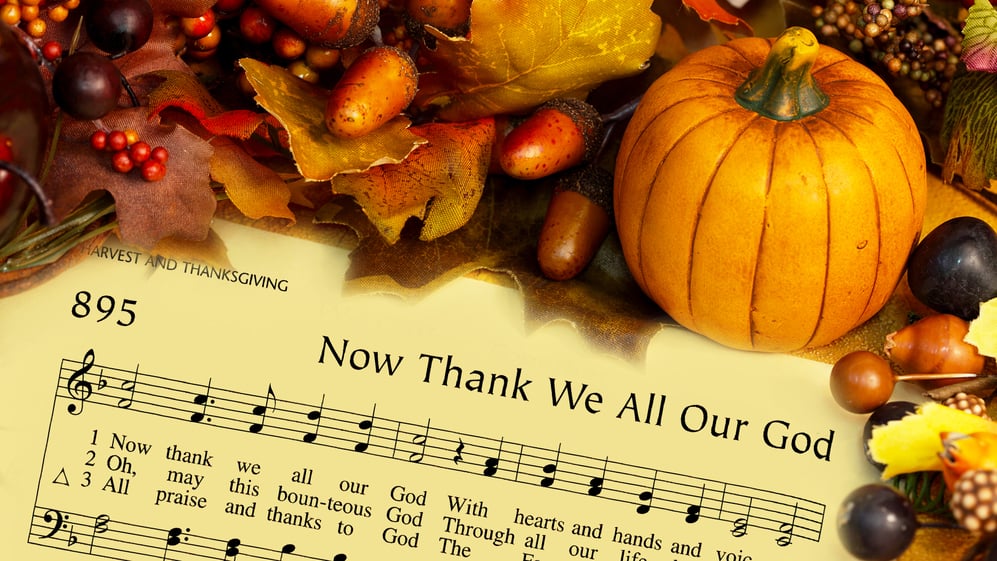November is a time of thanksgiving. We reflect and give thanks for everything that God has provided for us physically, spiritually, and emotionally. During this month, many churches, perhaps even your church, sing hymns of thanksgiving each Sunday. If you’re curious about the backstory and historical context of thanksgiving hymns (or any other hymn!), LSB: Companion to the Hymns is a great resource. To illustrate, we’ve picked three of these hymns and their histories to share in-depth.
Now Thank We All Our God
Hymn 895, “Now thank we all our God,” is a popular thanksgiving hymn that comes from a place of strife and struggle during the seventeenth century. Although once thought to be written in celebration at the end of the Thirty Years’ War in 1648, the hymn was first published in 1636. The hymn was written in German by archdeacon Martin Rinckart in Eilenburg, Germany. His pastoral service coincided with the Thirty Years’ War, when Eilenburg was under great pressure from refugees.
In 1637, a plague struck Eilenburg, killing members of the city council, other pastors, and Rinckart’s wife, Christine. The pastoral responsibilities of the town were laid entirely on Rinckart’s shoulders. During this time, he officiated at over four thousand funerals for those who had died from the plague. He took over duties for other parishes and became a point of guidance for the civic leaders who survived the plague. An extreme famine followed. As people lined the streets looking for food, Rinckart helped organize emergency assistance for the town and gave food to those who needed it. God always provided enough food for the Rinckart family to live. This hymn had previously been written as a mealtime prayer for Rinckart’s family.
Two years after the plague initially struck, Swedish soldiers marched to Eilenburg demanding payment of 30,000 thalers (an immense sum) to keep the city safe. Rinckart pleaded with the officers, knowing that the townspeople barely had enough for themselves, much less to keep their city. When the plea was refused, he gathered the people together to sing and pray before the soldiers. The soldiers were so moved that they reduced their demands to only 2,000 thalers.
Throughout these events, Rinckart believed that God would provide for himself and the people. He wore a ring inscribed with the word MVSICA, according to Companion to the Hymns. “[Rinckart] explained it as abbreviating the sentence Mein Vertrauen Steht In Christo Allein (‘my trust is in Christ alone’). Without question, Rinckart retained a trusting spirit in his Lord and in the certainty of His blessings. His hymn ‘Nun danket alle Gott’ [LSB 895] demonstrates this unwavering trust.”
On the scriptural history of hymn 895, Companion to the Hymns states, “This hymn is based on a passage from the apocryphal book of Ecclesiasticus: ‘And now bless the God of all. ...’ Luther’s German translation of the beginning of this passage reads (with modernized spelling): ‘Nun danket alle Gott, der groβe Dinge tut an allen Enden, der uns von Mutterleib. …’ This portion ... is transferred nearly word for word into Rinckart’s first stanza.”
Adapted from commentary by Robert J. H. Mayes; footnotes omitted.
Father, We Thank Thee
“Father, we thank Thee who hast planted,” hymn 652, “begins with eucharistic language: ‘we thank.’ This mirrors the blessings in the Didache, each of which begins with … we thank. This in turn mirrors the New Testament, where Jesus commonly gave thanks at meals—for example, at His miraculous feedings (Matthew 15:36) and the Lord’s Supper (Matthew 26:27). The term for thanksgiving, Eucharist, quickly became a lexical equivalent for the Lord’s Supper in the ante-Nicene Church,” Companion to the Hymns states. It also notes:
“The eucharistic prayer of the Didache is the oldest known in the Christian Church, predating the East Syrian anaphora of Addai and Mari and the anaphora of the Apostolic Tradition attributed to Hippolytus by a century or more. It includes a brief blessing of the cup, another blessing of the bread, and a lengthier post-Supper prayer. This little series of prayers was part of a liturgical manual comprising the latter portion of the Didache. It established a set of eucharistic rubrics in the Church that gave local congregations a liturgical foundation on which to judge the doctrines and practices of itinerant apostles and prophets. In so doing, the Didache took the initial step from Jesus’ words of institution in the New Testament to their liturgical use in the fledgling Church. This eucharistic prayer has continued to be developed and revised up to the present day.”
Adapted from commentary by Thomas A. Von Hagel; footnotes omitted.
Come, Let Us Eat
The author of hymn 626, “Come, let us eat, for now the feast is spread,” Billema Kwillia, grew up in Liberia and learned to read and write as a young adult in a local church’s literacy program. He learned Loma, one of thirty languages spoken in Liberia and the language in which this hymn was originally sung. He became a teacher in the literacy program in 1960, the same year he was baptized and became an evangelist. This hymn was first sung at a service he conducted. Later, it was recorded, transcribed, and translated.
The original hymn had three stanzas of three lines each, with a fourth stanza that repeated the first. Margaret Miller, the daughter of missionaries, provided the first English translation in 1969. Her translation kept the original 3/8 meter of the song. The first publication of this hymn was in 1970 in the fourth edition of Laudamus, the Lutheran World Federation’s hymnal. It appeared in three languages: English, German, and Loma. The English translation was deemed too awkward, so in preparing LBW, the editors changed the hymn to 2/4 to “accommodate a more felicitous revision of Miller’s translation.” A fourth stanza was later added to the hymn with an AABB form in a call-and-response format, which is in LSB today.
“With the altered text, the first two lines (the A section) are an invitation to the worshiper to eat, drink, meet, rest, and rise! The last two lines (the B section) are Christocentric in nature, discussing our Lord’s body, His blood, His presence, and His resurrection,” according to Companion to the Hymns. “The strong theological text of the fourth stanza moves communicants from the table into society at large as the gift of forgiveness in Jesus’ body and blood produces fruits that benefit not only the Church, but the world.”
Adapted from commentary by Jean R. Boehler.
Readings adapted from Lutheran Service Book: Companion to the Hymns, copyright © 2019 Concordia Publishing House. All rights reserved.
For more devotional, historical, and contextual information on every hymn in LSB, order Companion to the Hymns below.















.jpg?width=50&height=50&name=IMG_20220621_160541_456%20(1).jpg)